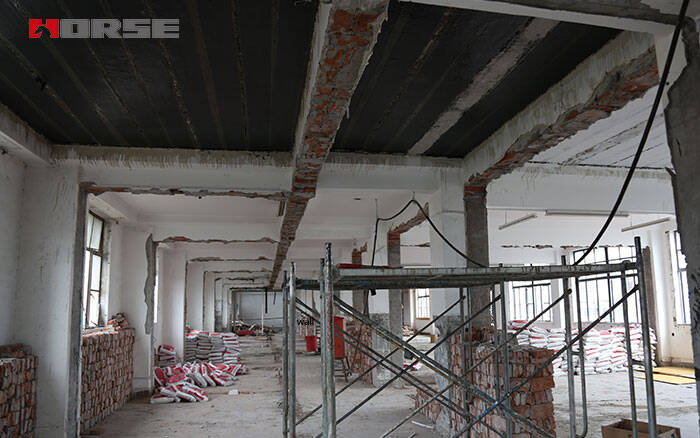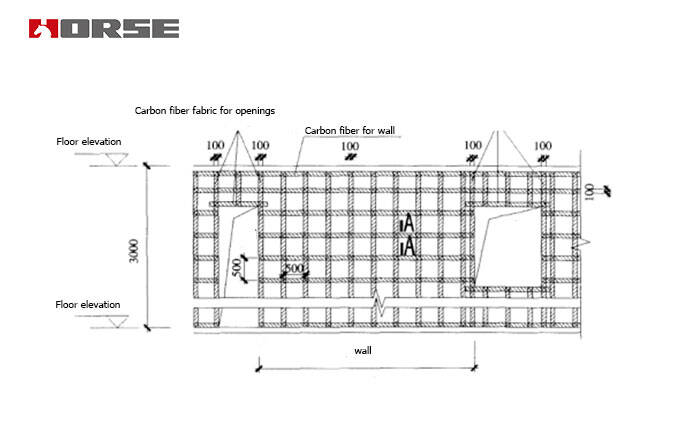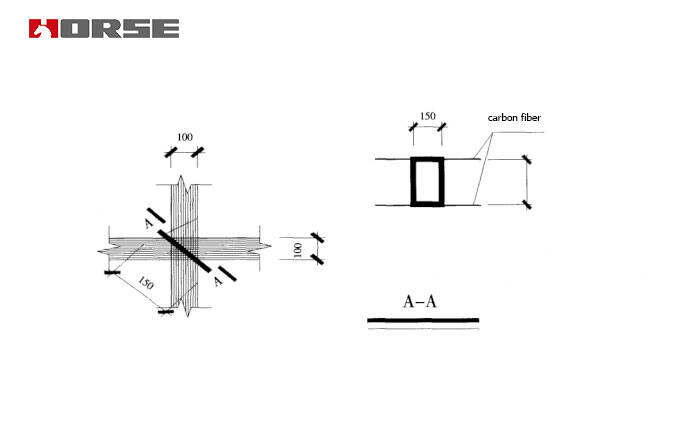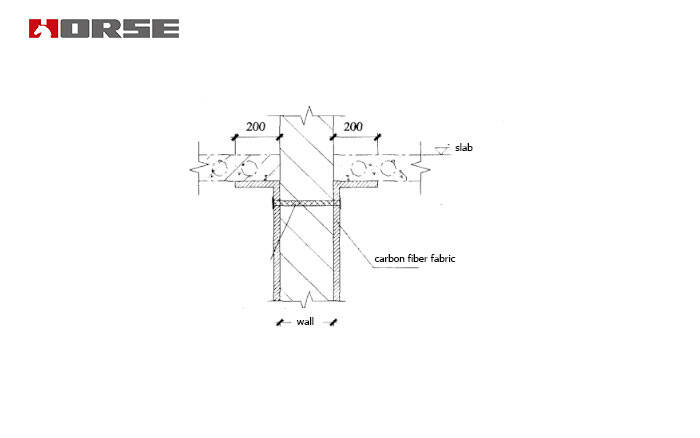Estructura de mampostería de ladrillo de refuerzo
Mampostería de ladrillos reforzada con tejido de fibra de carbono
El esquema de diseño de este proyecto se analiza desde cuatro aspectos de costo, período de construcción, función de servicio y efectividad de la mejora del desempeño sísmico, y se determina el refuerzo de tejido de fibra de carbono como el esquema óptimo.

1. Estudio de ingeniería
En 1986 se construyó un edificio docente en el distrito de Shijingshan de Pekín, con una superficie construida de 4300 m². La primera planta es una estructura de armazón y las plantas segunda a cuarta son de ladrillo y hormigón. La altura de la primera capa es de 3,8 m, la de la segunda y la tercera, de 3,6 m, la de la cuarta, de 3,8 m y la altura total es de 14,8 m. Se ha demostrado que la capacidad sísmica del edificio no cumple con las disposiciones pertinentes de la ingeniería de seguridad de edificios de escuelas primarias y secundarias nacionales. Tras el refuerzo, la intensidad de fortificación sísmica del edificio diseñado debe alcanzar los 8 grados.
2. Diseño del refuerzo
2.1 Plan de diseño
El esquema de diseño de este proyecto se analiza desde cuatro puntos de vista: coste, plazo de construcción, función de servicio y eficacia de la mejora del rendimiento sísmico, y el refuerzo con fibra de carbono se considera el esquema óptimo.
(1) Si se adopta el método tradicional de refuerzo de losa de hormigón armado en este proyecto, la sección viga-columna del marco de la primera planta aumentará considerablemente con el aumento de la carga superior. Esto tiene un gran impacto en la función de uso de la primera planta. Además, la cimentación de las columnas del marco requiere una ampliación, incluso de cimentación independiente a cimentación de losa, lo que resulta en una prolongación del plazo de construcción y un aumento sustancial del coste. La fibra de carbono ofrece las ventajas de ser ligera, soportar poca carga adicional tras el refuerzo, influir poco en la cimentación del edificio y requerir poco refuerzo de cimentación.
(2) El informe de evaluación sísmica de este proyecto muestra que la resistencia a la compresión de la estructura de mampostería superior cumple los requisitos, la capacidad de corte es insuficiente, el número de columnas estructurales originales es insuficiente, la sección transversal de las vigas anulares es pequeña, la ductilidad del muro requiere un refuerzo, y la fibra de carbono ofrece la ventaja de aumentar la ductilidad de la estructura.
(3) Desde el punto de vista del uso, el espacio libre del aula no puede reducirse excesivamente. Independientemente de la longitud o el ancho del aula, si se reduce más de 100 metros, los estudiantes tendrán dificultades para colocar pupitres y sillas, y el refuerzo de hormigón proyectado del muro del espacio libre del aula generalmente reducirá entre 160 y 200 metros. El uso de tejido de CFRP para reforzar las paredes de las aulas generalmente reduce la altura libre en tan solo 50 a 60 R/m.
2.2 Puntos principales del diseño
Los puntos clave del diseño incluyen la selección del tejido de fibra de carbono, la determinación de la disposición de los planos, el modo de anclaje y las medidas de sellado de los bordes.
(1) Elegir tejido de fibra de carbono. La mampostería de ladrillo presenta baja resistencia, baja ductilidad y mala adherencia entre el CFRP y la pared, por lo que no es adecuado utilizar CFRP de alta resistencia. Elegir CFRP de grado II de 200 g.
(2) Disposición del tejido de fibra de carbono. Cuando la relación de aspecto es superior a 0,5, se adopta el esquema de colocación de tipo "pozo", y cuando la relación de aspecto es inferior a 0,5, se adopta el esquema de colocación de tipo "ocho".

(3) Medidas de anclaje. Las medidas de anclaje tienen poco efecto sobre la carga de fisuración, pero una gran influencia en la carga de rotura última. Actualmente, numerosos experimentos han demostrado que el método de anclaje más fiable es presionar a través de la superficie de los clavos de carbono en la intersección de la fibra de carbono. Simultáneamente, las tiras de fibra de carbono de la parte superior del muro se pegan a lo largo de 200 m con la parte inferior del suelo, y la fibra de carbono se presiona sobre la superficie de los clavos de carbono a través del muro a 150 m por debajo del suelo.


(4) Contenido del diseño detallado. El espaciado de la malla de fibra de carbono, la disposición de los clavos de carbono, las juntas y los bordes de sellado deben diseñarse detalladamente. El esquema de diseño de este proyecto consiste en reforzar el muro principal con una disposición bidireccional de una sola capa de CFRP de 200 g con un ancho de 100 m. El espaciado longitudinal y transversal es de 500 m. Se utilizan clavos de carbono para presionar la intersección. El diagrama esquemático de refuerzo de la unión entre el muro y el suelo se muestra en el diagrama.